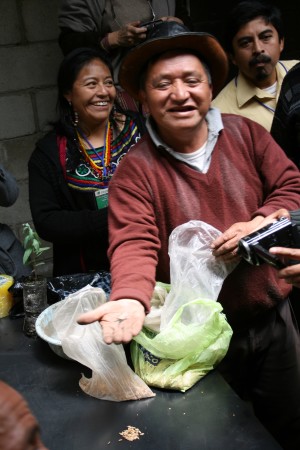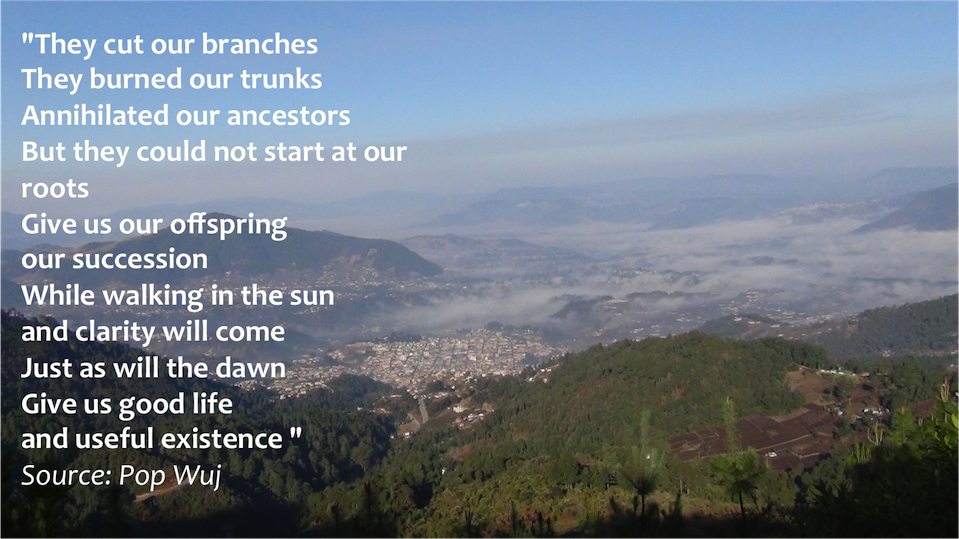
From the 17th till the 27th participants from various Central American countries and beyond shared knowledge and experiences in two very exciting meetings.
The first meeting focused on the role of cultural, spiritual and sacred values in sustainable forest management. The meeting, organised by Oxlajuj Ajpop, the Sacred Natural Sites Initiative (SNSI) and supported by Natural Justice served to capacitate participants from three indigenous communities on the development of Biocultural Community Protocols as a tool to help protect their sacred natural sites and forests.
“Sacred sites are places of ceremony, central to peoples spirituality. It therefore didn’t take long for them to be termed the heart of ICCAs” Grazia Borrini Feyerabend, Global Coordinator of the ICCA Consortium.

From Little things big things grow. This is true, even for the majestic forests of Totonicapan. Here at the tree nursery community members explain how local seed selections helps with growing trees that are just right for their forest. Source: Bas Verschuuren, 2013.
The second meeting was the first regional meeting of the ICCA Consortium that was co-organized by Oxlajuj Ajpop, Ut’z Che, the Global Diversity Foundation and SNSI. A range of presentations on indigenous and community conserved areas from the region showed a richness of experiences in traditional, use and conservation and governance of ecosystems:
– The indigenous territory of the Xpujil in Mexico,
– The importance of sacred natural sites in Guatemala,
– The marine community reserve Tarcoles in Costa Rica,
– The Indigenous territory of the Kuna in Panama,
– The law and the Mayagna in Nicaragua,
– Indigenous territories in El Salvador.
Although most ICCAs in Central America are understood under different and often local or regional names the participant agreed that a common plan and strategy should be shaped in order to preserve these unique and biodiverse territories.
Almost all of the presentations made reference to sacred sites being sources of spiritual well-being located in indigenous and local communities’ territories. After a sturdy climb, the participants of the first meeting experienced a local sacred natural enclosed by vast community managed forests and located on top of mountain overlooking Totonicapan. Later the tragic news arrived that the sacred natural sited and its surrounding forests had been allocated to families to harvest and farm as they see fit.
The faith of this sacred natural site is one of many examples of threats that face ICCAs and SNS. Because these places are often not recognised sufficiently my municipal planners and administrators they often get lost when legal title of community ownership is taken away. In addition, unbridled forestry, mining, urbanisation and infrastructural development scored high on the list of threats across the region. Other threats were noted to creep up more slowly such as state education and religious conversion that systematically do away with people’s indigenous knowledge and worldviews.

The earth from above! At 2700 meters the ceremonial centre of a sacred natural site offers impressive views of Totonicapan. In the foreground to the right you can see the impact of the allotment of community forest to local residents that prefer to cut trees for timber and agriculture. Before the end of the meeting the participants learned that community governance is not always well respected, allotments had recently been handed out that include the sacred natural site form which this image was taken. Source: Bas Verschuuren, 2013.
Despite the challenges participants from both workshops were energised and motivated to counteract the forces against them and their territories. Supported by a decent quantity of lawyers the meetings allowed the participants not only to get an outlook on international environmental and human rights law but also to get detailed information on cases and jurisprudence from the region. Much of this had direct relevance to the problems the communities face and especially the Biocultural Community Protocols were seen as good first step to start structuring the communities’ traditional knowledge, use, values and assets within a framework of local, national and international law.
The Biocultural Community Protocols are not a panacea for solving all the problems a community has. They are however mentioned in international law and when initiated and developed by local communities they can be an important tool for strengthening the community from the inside and negotiating their interests with outsiders. Eli Makagon, International Environmental Lawyer with Natural Justice.






